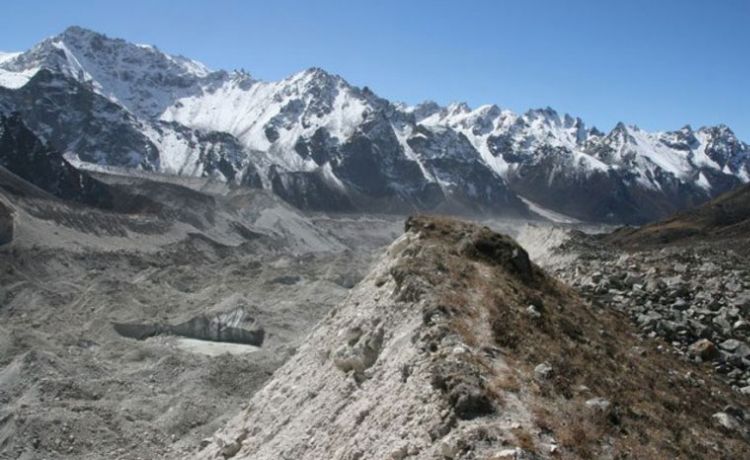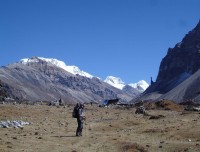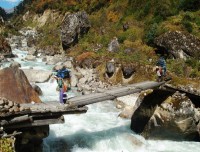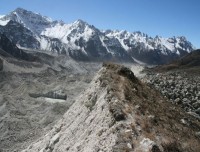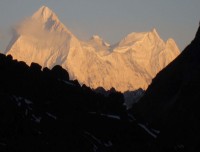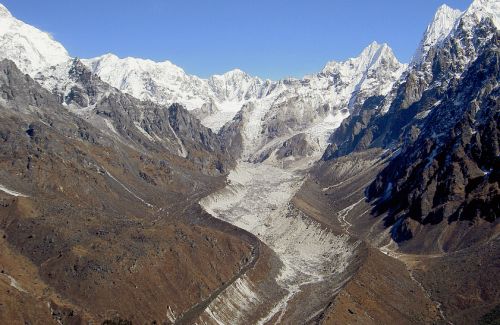Lumba Sumba Trekking
- Duration22 Days
- Max. Altitude5,200 m
- Starts FromUSD 2450
Destination:Nepal
Trip Grade:Strenuous (****)
Meals:Breakfast + Lunch + Dinner
Transportation:Private Vehicle / Aeroplane
Accommodation:Lodge + Camping
Trekking Region:Kanchenjunga Region
Show AllLumba Sumba Trekking is a newly explored trekking destination. Lumba Sumba Peak at the height of 5200 m is the prime attraction of this route. We can meet many local people of different ethnic groups, very friendly and hospitable, mainly they are Limbus, Sherpas, Rai, Gurung, Magars, Newars, Tamangs living in harmony in the eastern part of Nepal.The trek goes through Kanchenjunga Conservation Area (KCA) in the eastern Himalaya. We can explore two well preserved areas of Nepal: Kanchenjunga Conservation Area and the Makalu Barun National Park.
We can trek to Kanchenjunga and Makalu Base Camp through Lumba Sumba trekking route. Many species of wild animals and plants have enriched the Lumba Sumba Trekking trail. There are high mountain lakes and the rivers especially the Tamor and Arun River. The alpine grass lands, rocky outcrops, dense temperate and sub-tropical forests and low river valleys have made the Lumba Sumba trekking so special.
We fly from Kathmandu to Suketar, Taplejung or we can drive from Kathmandu to Fungling and begin our trek. There is no problem of tea houses and local lodges till Olangchung Gola but after this there is sparse settlement and we do camping.The trek ends at Num Village. Himkala Adventure organizes such trekking as per your interest. You could customize your trip. The itinerary can be changed as per your time constraint and budget. We always offer the standard service.
Trip Highlights
- Sightseeing at World Heritage Sites in kathmandu
- Scenic flight from Kathmandu - Suketar - Kathmandu
- beautiful cardamom fields and Alnus trees forest
- Spectacular views of two waterfalls
- Panoramic view of Kasturi peak and Tamor river
- See the habitat of Red Panda (if lucky, can see Red Panda on the bamboo bush)
- Visit 465 years old monastery with golden manuscript
- Pass through Lumba Sumba Peak (5200 m)
- Incredible Himalayan landscape
- Meet many ethnic groups and learn about their culture
Day to Day Itinerary
Day 01:Arrival in Kathmandu (1,350 m) and Transfer to Hotel. Overnight at Hotel
Day 02:Sightseeing at World Heritage Sites and Trek Preparation. O/N at Hotel
Day 03:Fly from Kathmandu to Suketar, Taplejung, 40 min. O/N at Tented Camp
Day 04:Trek from Fungling to Pawa Village (lunch), then to Mitlung (909 m), 7 hrs. O/N at Tented Camp
Day 05:Trek from Mitlung to Siwa Bazaar (lunch), then to Chiruwa (1,246 m), 6 hrs. O/N at Tented Camp
Day 06:Trek from Chiruwa to Tapethok (lunch), then to Lelep (1,687 m), 6 hrs. O/N at Tented Camp
Day 07:Trek from Lelep to Gowatar (lunch), then to Ela Danda (2,051 m), 4.5 hrs. O/N at Tented Camp
Day 08:Trek from Ela Danda to Maguwa (lunch), then to Selep Kharka (2,525 m), 5 hrs. O/N at Tented Camp
Day 09:Trek from Selep Kharka to Ramite (lunch), then to Olangchung Gola (3,208 m), 5 hrs. O/N at Tented Camp
Day 10:Trek from Olangchung Gola to Jadak (lunch), then to Upper Langmale (3,893 m), 5.5 hrs. O/N at Tented Camp
Day 11:Trek from Upper Langmale to Tangchetar (lunch), then to Pass Camp (4,747 m), 5.5 hrs. O/N at Tented Camp
Day 12:Trek from Pass Camp to Lumba Sumba Peak (5,200 m), then to Chaurikharka (4,594 m), 4.5 hrs. O/N at Tented Camp
Day 13:Trek from Chaurikharka to Thudam (3,500 m), 6.5 hrs. O/N at Tented Camp
Day 14:Trek from Thudam to Kharka (2,877 m), 5.5 hrs. O/N at Tented Camp
Day 15:Trek from Kharka to Chaurikharka (lunch), then to Chyamthang (2,229 m), 6 hrs. O/N at Tented Camp
Day 16:Trek from Chyamthang to Gimber Village (1,585 m), then to Hatiya (1595 m), 6.5 hrs. O/N at Tented Camp
Day 17:Trek from Hatiya to Gola (1,580 m), 5.5 hrs. O/N at Tented Camp
Day 18:Trek from Gola to Hedanga Gadhi (1,800 m), 5 hrs. O/N at Tented Camp
Day 19:Trek from Hedanga Gadhi to Num Village (1,575 m). 5 hrs. O/N at Tented Camp
Day 20:Drive from Num to Tumlingtar (1,230 m), 6 hrs. O/N at Tented Camp
Day 21:Fly from Tumlingtar to Kathmandu (1,350 m). O/N at Hotel
Day 22:Departure to International Airport
Cost Include
- Airport picks up & drops off by private tourist vehicle
- A government licensed holder city tour guide
- 3 nights’ twin sharing 2-3 star hotels in Kathmandu with Breakfast
- Guided city tour in Kathmandu by private tourist vehicle
- Full board meals (Breakfast + Lunch + Dinner) during the trek
- Tented camp accommodation during the trek
- Professional license holder English speaking Trekking guide
- The required number of local staff and porters to carry your luggage during the trek
- Food, accommodation, salary, insurance, equipment and medicine for all staff
- All required camping equipments during the trek
- Kanchenjunga/Makalu Coservation Area permit, National Park Fees and TIMS permit
- Down Jacket, Duffle bag and sleeping bag by Himkala Adventure if required
- Airfare from Kathmandu - Suketar - Kathmandu including airport departure taxes
- Farewell dinner in traditional Nepali restaurant with cultural show
-
All our government taxes, vat & service charges
Cost Exclude
- Lunch and dinner in Kathmandu & Pokhara
- Entrance fee in all monuments during tour
- Emergency rescue and evacuation cost
- Your travel insurance
- Nepal entry visa fee which is issued at Kathmandu Airport
- Personal expenses like phone bills, laundry,alcoholic,non-alcoholic drinks etc
- Personal trekking equipment
- Tips for trekking, tour staff and driver (Tipping is expected)
- Any others expenses which are not mentioned on ‘Cost Includes' section
Trip FAQ
Himkala Adventure would like to quench the thirst of all necessary questions answers about Lumba Sumba Trekking for all curious travelers/trekkers in the world. As you are entirely from different geographical location, you could better to know everything about the treks from the beginning i.e. airport pick up till your departure like airport picks up, drops off, accommodation in city, in the trek, guide and porters, safety for the trekking, food and accommodation and some other things that you might face on the way. Hope our endeavor listing these questions answers will help you self informed.
This is simply the outlines of the services we offer but it may differ as per your requirement, number of trekkers. What we go through our conversation, we will manage the means of transportation, hotels in the city, accommodation in the trekking, numbers of porters etc. This is general idea about Lumba Sumba Trekking before your trip and you become clearer about the trek. Please feel free to contact us to get more information about the trekking in the Himalayas of Nepal.
1) How is Lumba Sumba Trekking in Nepal?
Lumba Sumba trekking is the less touristic and newly explored trekking route in eastern part of Nepal.The name of this trail was derived from the name of the Lumba Sumba peak.The main attraction of this route is spectacular view of Kanchanjanga Himalaya and Makalu Himal. The landscape is really unique and beautiful. The culture of Limbu, Sherpa, Rai, Gurung, Magar, Newar and Tamang is interesting to learn in this trek.
2) What physical fitness do I need to book this trip?
Every trekking in the Himalayas of Nepal require the certain level of physical and mental fitness.So, we advise you to be in good physical shape and able to feel comfortable while hiking up and down 7 to 12 miles per day on a trail carrying a day pack of about 10 pounds. Three things could make you confident enough for any trek you would like to do: aerobic, strength and mental.
Aerobic conditioning is important primarily because you will be trekking in thinner air, up to 40% less than at sea level. With good aerobic conditioning, you will be able to better metabolize whatever oxygen is available to you. You should plan on doing at least one hour of aerobic 3 /4 times per week for 1 month or more before your arrival in Nepal. Walking, jogging, cycling, hiking on valley floor to ridge line ascents with day back are some of the excellent forms of exercise, so long as you are strengthening leg muscles and building stamina. Speed is not the essence; stamina, confidence and continuity are.
3) How do I find Himkala Adventure for my pick up at the airport?
Our representative from Himkala Adventure will display a small board of company or with your name outside the airport terminal. You will be driven to the hotel by our tourist vehicle.
4) What sort of accommodation do I get in Kathmandu?
Normally we provide standard rooms with twin sharing accommodations at three star or similar category hotels in Kathmandu including breakfast. Accommodation in these cities can be upgraded as per your request. But some of our packages are sold without accommodation in the city.
5) How is camping trek during Lumba Sumba Trekking?
Camping trek to Lumba Sumba is fully organized and supported, with a team of guides, cooks, and porters to accompany you. Our porters carry all the trekking gear, food, fuel and personal belongings. Our cooks prepare hot meals. Trekkers need only carry a small bag as required for the day. At night, tents for dining, sleeping and ablutions tents are provided and set up, also mattresses and down-filled sleeping bags, tables and seating.
In a typical camping trek, we start the day around 6 a.m. with a cup of hot tea. You are then provided with a bowl of warm water for washing. Then trekkers enjoy breakfast before leaving camp. The trek begins around 7.30 - 8 a.m.Trekkers can set their pace for pausing and sightseeing and the walk to the lunch spot will normally take 3 hours. On arrival, you are served hot lunch. In the afternoon, after walking for another 3 to 4 hours, you arrive at the next camp around 5 p.m. Tea & snacks are served while our staff readies the camp. Dinner time is around 6/7 p.m. in the dining tent, lit with lanterns and comfortably furnished. The food is healthy, wholesome and hygienically prepared.
6) What mode of transportation do I use?
We will provide the private transportation for Airport/Hotel/Airport pick up and drop and sightseeing in Kathmandu Valley. We use transportation as based on our cost inclusion section. The transportation varies depending on your requirements at the time of booking the trip.
7) What is the best season for this trekking?
The best season for Lumba Sumba Trekking is spring (March to May) and autumn (September to December). These are the perfect time of the year for the breathtaking views of Himalayas with clear and sunny days. But the weather in the mountains is unpredictable.
8) What is the weather and temperature like during the trekking?
The climate in Nepal varies from place to place which can be categorized in different four main seasons. The main seasons in Nepal are spring (March to May), summer (June to August), autumn (September to November) & winter (December to February). The best season to travel in Nepal is autumn (September, October & November) & spring (March, April & May). Weather in the mountains is unpredictable. But the day temperature in Lumba Sumba Trekking is comfortable.
9) Who will be guiding me during this trip?
We provide the professional government license holder English speaking trekking guides for our entire trekking trip. We can also provide French, Spanish, Japanese, German or Italian speaking guides as per your preference with extra payment but not guaranteed. All guides will be Nepali people who are carefully selected on the basis of their appropriate experience, leadership skills and personality. They are all trained from Nepal Academy of Tourism and Hotel Management, certified and approved by the Tourism Department of Nepal government. We provide a different city tour guide to guide you in UNESCO World Heritage Sites in Kathmandu. They are the professional license holder guide specialized in culture, history, geography, iconography, archeology and religion with good command over English. Tour guides are specialized in city tour and trekking guides are more in the hiking and trekking in the Himalayas.
10) What sort of experience do your guides have?
Our entire city tour guides have bachelors to Master Degree academic education along with many months tour guiding training from Nepal Academy of Tourism and Hotel Management, Rabi Bhawan, Kathmandu, Nepal. They are fluent in spoken languages and informative about the sites in many aspects. They are quite experienced and dedicated to their job and responsibilities.
Our entire trekking guides have minimum Intermediate to Master Degree academic education with trekking guide training from Nepal Academy of Tourism and Hotel Management, Rabi Bhawan, Kathmandu, Nepal. Many of them are from villages. As they are local, they know more about the routes, necessary precaution to be taken and so on. They have spent many years exploring many parts of the country. They are trained in first aid and able to handle any situation easily. They speak good English and make you know about the places you visit.
11) May I charge my electronic devices during Lumba Sumba Trekking?
This is fully camping trek, so we may not be nearby any settlements. You could better manange extra battery or any other alternatives.
12) What is the social and environmental responsibility of Himkala Adventure for this trip?
The situation of environment in Nepal is in considerable stage due to so many factors caused by global warming, human activities, and adverse effects of natural incidents. Nepal is in between two giant countries like China and Nepal. The ozone layer is depleting and the atmosphere is getting heated. So, its direct effect is to the Himalayas that the snow is melting day by day and the sea level is rising. It is due to population growth, people are clearing the forest and the soil is being eroded. As a part of society, and our trekking related activities are directly concerned with the social and environmental things. We are very conscious not litter in the open spaces, to manage garbage properly and make local people aware in this campaign. We are working together with other companies and taking these issues seriously.
13) What is the minimum number requirement for this trip?
We operate individual trip to the group joining trips for Lumba Sumba Trekking. If you want to do any private trip we are ready to organize for solo traveler as well with some additional charges.
14) Are there communication or internet services during Lumba Sumba Trekking?
We highly recommend taking local SIM card for call and internet services during trekking. Local SIM cards are easily available in many stores and at airport as well. You need to provide two copies of your photographs and your passport copy to get local SIM CARDS of NCELL & NTC (only these two companies provide telephone services in Nepal
15) May I add extra days in trekking?
We are ready to operate your holidays as per your interest and requirements. You can spend extra days on your loving or favorable places or even can make it shorter. We will always do our best to manage your hotel bookings, flight booking and everything.
16) What happens in case of emergency?
Himkala Adventure has prepared for any emergency situation and knows how to handle it. Our guides are trained in first aid and can deal with most of the basic ailments that occur during the trek. Every client should have his own insurance before coming to Nepal for the case of emergency.
17) Do I need to have insurance for this trip?
We request you to have a travel-insurance policy to cover theft, loss, medical problem & emergency helicopter evacuation from high altitude places before coming Nepal. Choose a policy to cover your emergency high altitude helicopter evacuation with all medical insurances for trekking in high altitude in the Himalayas of Nepal. Your travel insurance is always needed before going in any high altitude trekking. Please check your travel insurance policy which doesn’t exclude mountaineering or alpinism. Although you will not be engaging in these activities in your trekking, you might have problem convincing the insurance company of this fact. Rescue insurance need to cover an emergency helicopter evacuation or a charted flight from remote mountain trails of Nepal as well as international medical evacuation. A helicopter evacuation might cost US$ 2500 to US$10000 depending on the places. So that travel insurance to cover all above is must to travel in the high Himalayas of Nepal
18) What type of shoes should I wear during Lumba Sumba Trekking?
You could better have carefully chosen hiking boots with extra laces and camp shoes, which should be kind of strong, well-made but light boots for Lumba Sumba Trekking. Shoes and boots are best to buy before arriving in Nepal. We advise you to wear your new shoes for sometime before trek so that you could feel well habituated on the newer trail for your feet.
19) Can I use credit cards in Lumba Sumba Trekking?
Of course not, you can use only in the cities like Kathmandu but not in Lumba Sumba Trekking route. When you are out of city, all you need is cash, better to have small notes. Please change the currency in local Nepali rupees before you go to the mountains.
20) Do I need to tip my guide and porter? How much would that be?
Tipping is not mandatory, neither it is right to ask by anyone but it is a way of showing gratitude after taking service. The level of tip also shows how satisfy you are from the team that you had been during your tour/trek.However, we recommend you to spend minimum 10% of your total trip cost for tipping entire local staffs, the ratio of tipping guide and porter will be given to you at the pre-trip meeting in Kathmandu before starting the trek.
Trip Note
Cost:
The cost of trip varies according to the number of travelers in the group, the category of the Hotel, mode of the transportation and any kind of changes (if there is). So, if you would let us know all of these above mentioned things, then we could quote you the exact price.
Essential Documents:
You are requested to send the following documents after you confirm or book the trip with Himkala Adventure:
A copy of your passport and travel/health insurance documents with contact details, three passport size photos.
It is advised to maintain a separate photocopy of all important documents including traveler’s cheques, bank/ATM card, contact numbers, international flight tickets, and emergency contact numbers.
Weather:
The main trekking season in Nepal is from October to December and March to May. The day temperature for walking to Lumba Sumba Trekking is comfortable. The sky is clear although there is snow and rainfall occasionally. It is about 10 degree centigrade at the height of 3,600 m and increasingly lower, the higher we go.
Extreme Weather and Airport Closures:
Weather conditions in the Himalayas are unpredictable. Flights can be cancelled or delayed due to bad weather. Flights to and from Suketar may be delayed or cancelled due to bad weather. There is no other alternative except having patience for the good weather or have some optional trip around or chartering helicopters. You will be accommodated at your joining hotel at your own expense.
Nepal Strikes:
There is much more progress in the political scenario in Nepal and we assure you that travelling in Nepal is safe. But there may be Bandha (wide transport strikes) at a very short notice. The shuttle bus is in operation by Nepal Tourism Board and the Nepal Tourist Police in conjunction with the Himalayan Rescue Association from domestic and international terminal to the various hotels in Kathmandu. The service costs 300 rupees per person.
Itinerary Disclaimer:
The itinerary is only for those who choose the complete package. We can change the itinerary as per your requirements and interests. We always offer you the standard service but it may depend on the program you have chosen and the financial procurement.
Himkala has thoughtfully designed all the itineraries but our itineraries are updated for the betterment on the basis of our past travelers’ comments and our own research. In case you find changes in the itinerary you printed and the upgraded one does not affect your trip. Please note that some changes may occur in our itineraries due to bad weather and common seasonal changes to timetables and transport routes.
Physical Rating:
Your trip will be meaningful if you could find yourself fit and fine. You will be walking up to 5,200 m from the sea level. As the geographical region varies, there is a temperature variation as well. So, we advise you to undertake regular physical exercise, jogging, hiking, riding, ascending and descending the long stairs etc.
Group Size:
Himkala Adventure organizes solo to group travelers. Our group trips are designed for sharing accommodation and there is no single supplement. Single travelers share with the same gender from twin to multi-share in an accommodation. You are requested to have mutual understanding in between the fellow travelers who have joined from the different parts of the world. Please remember that you have great responsibilities in the group. If you are requested to be at a particular place at a certain time, make sure that you have been there at a time. It is much more pleasing sharing experiences and traveling together.
Accommodation and Meals:
Accommodation and Foods in the Himalayan region of Nepal cannot be compared with any developed countries in the world. We know that you might not have experienced such things before but you should take it easy. Accommodations at local lodges are simple but clean and comfortable. The food is plain. Toilets and washing facilities are shared and rudimentary. In high altitude regions, there are very few tea houses and one has to be happy to share in simple dormitories without electricity, without running water. Hot shower means a bucket of hot water upon our request.
Money Matters:
Please note that most establishments in Asia will not accept foreign currency notes that are old, torn or faded and they can be very difficult to exchange or extra fees added when exchanging at banks. Please ensure that you have new, clean notes.
The official currency of Nepal is the Nepali Rupee (NPR). ATMs can be found only in major cities of Nepal like Kathmandu, Pokhara, Chitwan, Bhaktapur etc. The government of Nepal has banned the import, export and use of 500 and 1000 Indian rupee notes in Nepal. You make sure that you won’t carry these notes upon arrival in Nepal, otherwise they are confiscated and you may be fined.
Please make sure that the foreign currency notes that you have are new and clean notes because old, torn or faded foreign currency notes in Nepal are very difficult to exchange or extra fees added when exchanging at banks.
While travelers cheques have security advantages exchanging them can be a lengthy process, commissions can be high (up to 10%) and they can be difficult to change in rural areas, on weekends and public holidays. If you choose to bring travelers’ cheques, make sure they are a major brand and major currency.
Tipping:
Tipping is not mandatory. It is not anyone’s right asking for tips but if you are happy with the service, you could tip the staffs. It is entirely a personal preference. Tipping could be significant to them who took take great care of you in your traveling period. Himkala recommends that you could tip any intended recipient by any member of the group than collected and passed on by the group leader.
Note: Please do not tip with coins or dirty and ripped notes. This is culturally taken as an insult.
Local Dress in Nepal:
Nudity is a sensitive issue in Nepal. Women should avoid wearing shorts and sleeveless tops in public places where this might be seen as inappropriate. Remove shoes before entering certain holy places. Non-Hindus are not permitted in some temples.
Feedback:
Your feedback will be the great guidance to meet our target and to bring improvement in our service. What and how have you experienced with Himkala Adventure and our staff? Please write, we will read it carefully. One cannot see his/her shortcomings that are lying with them. Someone should point it out. We are always eager to hear from you.
Trip Info
- Trip FAQs
- Washing and Shower
- Water/Food and Nutrition
- Trip Grading
- Weather
- Accommodation/Shelter
- Altitude Sickness
- Communications and Updates
- Conservation
- Cross Cultural Issues
- Essential Do’s and Don’ts
- Foot Ware/Foot Care
- Health and Fitness
- Himkala Crews
- Hypothermia
- Safety and Security
- Travel Insurance and Evacuation
- Equipment List
